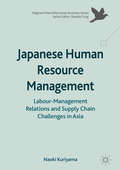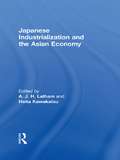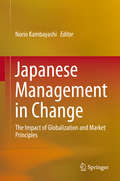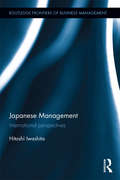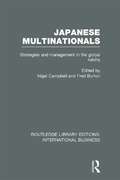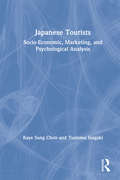- Table View
- List View
Japanese Global Management
by Katsuo YamazakiThe Japanese management style is unique compared with those in the U. S. and Europe as is the overseas operation for Japanese companies. This book demonstrates the three essences for successful overseas operations that global enterprises as well as Japanese companies possess.
Japanese Global Strategy: Overseas Operations And Global Marketing
by Katsuo YamazakiThis book examines the global corporate strategy of Japanese multi-national enterprises (MNEs) and analyses their position in today’s business environment. Focusing in particular upon Indonesia, Kenya, Nigeria, South Africa, Sri Lanka and Vietnam, Japanese Global Strategy presents nine empirical case studies on companies including Denso, Furukawa Electric and Yamaha Motor. Based on questionnaires and interviews with senior managers, this book applies the hybrid theories of application and adaptation to each company’s corporate strategy. By delving into the historical reasons behind investing in strategy, the author asserts that MNEs should be a priory for Asian markets, making this an invaluable read for anyone researching international business and Asian business more specifically.
Japanese Human Resource Management
by Naoki KuriyamaThis book is a comprehensive study underpinned by thirty years of research conducted by the author relating to Japanese human resource management and labour-management relations. Its aim is to achieve a better understanding of the Japanese model for human resource management and labour standards issues, and its transferability to supply chains in Asia. Seeking a better understanding of the strength of Japanese management and its applicability to foreign countries, Japanese Human Resource Management introduces a new agenda for Japanese corporations that wish to operate in sustainable and inclusive ways in local societies and in global supply chains. Organized into three major themes this comprehensive study is essential reading for students, researchers and government who wish to promote productivity improvement and constructive labour-management relations.
Japanese Industrial History: Technology, Urbanization and Economic Growth
by Carl MoskA detailed examination of the industrial development of Japan since the Meiji Restoration.
Japanese Industrial Transplants in the United States: Organizational Practices and Relations of Power (Studies on Industrial Productivity: Selected Works)
by Atsushi SumiFirst Published in 1998. Routledge is an imprint of Taylor & Francis, an informa company.
Japanese Industrialization and the Asian Economy: Edited By A. J. H. Latham And Heita Kawakatsu
by A.J.H. Latham Heita KawakatsuMuch has been made of the post-war Japanese economic miracle. However, the origins of this spectacular success and its effect on the region can actually be traced back to an earlier period of Asian history. In Japanese Industrialization and the Asian Economy the authors examine the factors which contributed to the period of major industrialization
Japanese Institutionalist Post-Keynesians Revisited: Inheritance from Marx, Keynes and Institutionalism (Evolutionary Economics and Social Complexity Science #29)
by Hiroyasu UemuraThis is the first book that systematically considers the academic achievements of Japanese institutionalist post-Keynesian economists in the postwar period and argues that we can learn much from their intellectual heritage. Those Japanese economists include the world-renowned figures, Shigeto Tsuru and Hirofumi Uzawa, whose inheritance came from Keynes, Marx, and institutionalism. In the era of globalization after the 1990s, economic inequality and social divide have intensified all over the world. In this situation, the academic achievements of those economists in postwar Japan should be reconsidered for the aim of establishing a new political economy. With this perspective, the book looks at what we can learn from Japanese institutionalist post-Keynesian economists In particular, the essence of research work that each of them developed is identified, focusing on the total image of the economy for contemporary capitalism. Those economists benefited from the diverse legacies of Keynes, Marx, Kalecki and institutionalist economists such as Veblen and Galbraith. When their research is examined systematically, Japanese institutionalist post-Keynesians are commonly characterized as those who developed their institutional analysis of contemporary capitalism with in-depth theoretical and empirical studies, with the aim of establishing their own political economy as the moral science of civil society. These important features provide us with insightful implications for institutional economics in the 21st century.
Japanese Investment and British Trade Unionism: Thatcher and Nissan Revisited in the Wake of Brexit (New Directions in East Asian History)
by Hitoshi SuzukiThis book revisits the long contested negotiation between the Thatcher administration and Nissan for the latter's first green-field plant in Europe. From the very beginning, the plant took Britain’s EC/EU membership and tariff-free access to the single market as a token. A considerable amount of aid including component supplies was provided to attract Japanese investment and to prevent its transfer to the continent. The successful launch of Sunderland highlighted improved Anglo-Japanese relations and put an end to the Japan-EC/EU trade conflict. But the price was paid by Nissan’s slump and fall, and by trade unions in both countries failing to keep counterchecks on management. Brexit and the fall of Carlos Ghosn were a double blow to Anglo-Japanese relations which are in a state of drift and need redefinition.
Japanese Inward Investment in UK Car Manufacturing (Routledge Revivals)
by Young-Chan KimThis title was first published in 2002. This compelling text provides fresh insight into an area that is often touched upon, but rarely examined in any great detail - the relationship between Multinational Enterprises (MNEs) and their host governments. Taking Japanese Foreign Direct Investment (FDI) strategy, arguably the model of FDI, Young-Chan Kim takes a revealing look at why the United Kingdom (UK) has dominated among the EU member states for FDI destination, while ironically losing its nationalized car manufacturers. Scholars of business history, international business and business economics will find this work invaluable.
Japanese Management Techniques and British Workers (Routledge Studies in Employment and Work Relations in Context)
by Andy DanfordFirst published in 1998. Routledge is an imprint of Taylor & Francis, an informa company.
Japanese Management for a Globalized World
by Satoko WatanabeThis book provides a comprehensive analysis of the changes that have taken place in the systems and practices of Japanese management over the last quarter century, identifies the positive and useful attributes that ought to be maintained, and clarifies the behavioral principles that form the groundwork of their strengths. Observing the changes in the business environment brought about by the forces of intensifying globalization, the book presents a highly effective management model that builds on the superior aspects of Japanese-style management while overcoming its weaknesses. It is a multi-layered human-resources management model that combines the mutually complementary aspects of the Japanese and Anglo-Saxon systems, incorporating the strengths of both systems. This hybrid model is aimed at increasing workplace motivation, promoting the creation of new value, and enhancing performance and can be used successfully in many countries around the world. It will be of interest to business strategists and consultants, scholars, and entrepreneurs.
Japanese Management in Change
by Norio KambayashiFollowing the burst of the "economic bubble" in the 1990s, many Japanese companies were required to reform their management systems. Changes in corporate governance were widely discussed during that decade in studies on "Japanese management. " These discussions have resulted in little progress, however, since Americanization became the dominant discourse concerning governance and the management system. There have been few studies conducted from an academic point of view on the internal aspects of organizations that practice traditional Japanese management theory. This book examines how, and the degree to which, the development of market principles accompanying the advances of globalization has affected the traditional Japanese system. It focuses on four aspects of corporate management: management institutions, strategy, organization, and human resource management. The aggregation of the new management system in Japanese companies is regarded as a distinctive Japanese-style system of management. With emphasis on these four aspects, research was conducted on the basic structure of that system, following changes in the market, technology, and society. Further, specific functions of the basic structure of the Japanese-style management system were studied. Those findings are included here, along with a discussion and analysis of the direction of future changes.
Japanese Management in Evolution: New Directions, Breaks, and Emerging Practices (Routledge Frontiers of Business Management)
by Tsutomu NakanoJapanese Management in Evolution illustrates the significant changes that have been taking place in Japanese business by focusing on "emerging industries" in the relatively neglected service and "creative" sectors as well as other key industries, and to put those changes in historical perspective by providing an overview of business development since World War II. By employing state-of-the-art research techniques and unconventional innovative approaches in analysing Japanese management – including network and discourse analysis, ethnographic explorations, and more – the book reveals historical developments and in-depth analyses of established and emerging composition of sectors and industries where cultural capital matters. Throughout the book, the common theme conveyed to readers is a consistently strong message that the change is ongoing and the evolution of management style is real in the Japanese context. The book would be of great interest to researchers, academics and practitioners in fields of global management, international management, and Asian capitalism.
Japanese Management: International perspectives (Routledge Frontiers of Business Management)
by Hitoshi IwashitaThis book provides a new understanding of the constellations of logics in Japanese management practices in Asia and the West. Through comparative ethnographic case studies in a Japanese multinational corporation (MNC), the book explores the cultural meanings of family, corporation, market and religion logics at each subsidiary’s site in Thailand, Taiwan, Belgium and the United States. In doing so, the book defines cultural space through an institutional logic approach. It argues that logics are culturally interpreted, which can impose a serious limitation on the institutional logic approach based on the analysis of Western society. It reveals that Japanese ‘family’ logics and Theravada Buddhism in Asia are strengthening each other and this directly supports the presupposition of amplification. It further elaborates on the ongoing constellations of logics that are continuously formed in relation to geographical contexts. The book also explains that the boundaries of organisational communities are not automatically formed by Japanese expatriates but constructed through actors’ profiles, which, in turn, raises their importance. Therefore, this book is a must-read for researchers, managers and anyone interested in Japanese MNCs.
Japanese Management: Tradition and Transition (Routledge Revivals)
by Arthur M. WhitehillFirst published in 1991, Japanese Management succeeds in filling a major gap by providing a thorough account of the evolution and day-to-day practices of management within the Japanese firm. The 14 chapters not only build the historical framework and modern cultural, economic, and social setting, but also effectively deal with the process of management. The final two chapters address some future challenges facing Japanese firms as they operate in the global business environment. This comprehensive book is a must read for students of business management.
Japanese Multinationals: Strategies and Management in the Global Kaisha (Routledge Library Editions: International Business)
by Fred Burton Nigel CampbellInternational in perspective, this volume provides insights into the important problem of how to transfer Japanese practice to Western countries. It also examines key aspects of Japanese multinationals and discusses how they are developing their global strategies and how they are managing their local workforces. Topics covered include relations with suppliers, governments and competitors, leadership patterns and business philosophy. The impact of Japanese multinationals on the local economies of host countries is a particular focus. The dynamics of strategic alliances, technology transfers and research and development centres are also discussed.
Japanese Outbound Acquisitions: Explaining What Works
by Shigeru MatsumotoThis book reviews the past 116 Japanese outbound acquisitions in three decades and determines success and failure, with the goal of explaining what works. Dr. Matsumoto emphasizes that such acquisitions are part of a long-term strategy and should not be judged based short-term gains and losses, especially short-term changes in company stock prices. The book also highlights common pitfalls hidden within the expected benefits of these overseas acquisitions. Dr. Matsumoto provides valuable insights for executives, corporate managers working on strategy, finance and overseas development, practitioners, researchers and MBA students trying to succeed in cross border merger and acquisitions using 16 case studies and careful investigation.
Japanese Participation in British Industry (Routledge Library Editions: Japan)
by John DunningJapanese participation in British industry has increased greatly in recent years. While the new investment is welcomed for the jobs it helps create and the injection of new technology and managerial techniques, many people are fearful lest this increased participation should lead to loss of control of British industry by British nationals and adversely affect British competitors and their struggle for global markets. These concerns are made worse by lack of knowledge about just how extensive Japanese managerial participation in British industry is and about how Japanese practices differ. This book, based on extensive original research, answers these and related questions. It is the first detailed study of the extent of Japanese participation in British industry, and of its economic impact in a number of key areas.
Japanese Phoenix: The Long Road to Economic Revival
by Richard KatzJapan will recover and its economic achievements will once again earn the world's admiration, with sustained annual growth of three percent, perhaps more, well within reach. This is the confident forecast that begins Japanese Phoenix: The Long Road to Economic Revival by the author of Japan: The System That Soured, which several years ago accurately predicted Japan's current travails at a time when others were prematurely pronouncing full recovery. Katz warns however that there is bad news to go with the good. So deep-seated are Japan's dysfunctions that, even if it did everything right today, it would take at least five years for truly vibrant growth to take hold. But Japan will not do everything right. Opposition to reform is deep-seated and a myriad of vested interests and millions of jobs are at stake. Still he notes, there is little doubt that reform will succeed. Japanese Phoenix tells the story of the struggle between the forces of reform and the forces of resistance. It dissects Prime Minister Koizumi's role in the process, and explains why Japan is in so much trouble and what needs to be done. It explore the debates among economists and gives a careful progress report on all the moves made so far in the name of reform - from greater direct foreign investment, to the financial "Big Bang", to ending one-party rule by the Liberal Democratic Party. Katz concludes that this is just the second round of a 15-round fight. Japan is a great nation currently trapped in obsolete institutions. As it has before, Japan will find a way to surmount its problems and regain its forward progress.
Japanese Retail Industry After the Bubble Economy: Development of the 100-yen Shops (SpringerBriefs in Business)
by Md. Arifur RahmanThis book highlights the major institutional changes in the development of the Japanese retail industry after the bubble economy. The Japanese retail structure has been transformed from an abundance of small retail stores to chain stores by notable institutional changes with continuous variations in the post-1990s. It provides an insight into the impact of retail density on the household economy in the stagnant economy of Japan. The issues highlighted in this book include the background of the advent of 100-yen retail stores and strategic approach of the stores during the stagnant economy, a comparative analysis of Japanese 100-yen shops and dollar stores in United States, employment compliance of 100-yen shops and dollar stores in developing countries, factors that contributed to change the Japanese distribution channels after the 1990s, and determinants of retail density in Japan. The stagnant economy in the post-bubble period, along with changes in the large-scale retail store law, led consumers to shift from the most popular department stores to supermarkets and the cheapest retail alternatives. With its recent data and theories, this research work will be of interest to business and economics students and researchers in Japanese retailing and relevant areas.
Japanese Tourists: Socio-Economic, Marketing, and Psychological Analysis
by K. S. Kaye ChonFind out how to entertain all types of Japanese tourists from student groups to retirees!Would a Japanese traveler rather see pictures of beautiful landscapes or smiling Japanese couples in a tourist brochure? Will you attract more Japanese tour groups by promising them independence and adventure or excellent food? Given the importance of Japanese tourists to the global travel industry, understanding their travel-related behavior has become an essential item in the tourism research agenda. Japanese Tourists: Socio-Economic, Marketing, and Psychological Analysis investigates the specific needs, behaviors, and desires of this growing segment of the international tourism market.Japanese tourists spend billions of dollars abroad every year, and travel destinations as far apart as Australia and Manhattan compete fiercely for their custom. By taking cultural traits into account, travel industry professionals can better understand exactly what kinds of amenities, accommodations, service, and total experience Japanese travelers are looking for. This volume of original research and well-grounded theory elucidates the specific factors that go into Japanese travel and buying decisions, whether the travelers are Japanese ”office ladies” seeking bargains in Hong Kong or a group of senior citizens hoping to see the Northern Lights.Japanese Tourists: Socio-Economic, Marketing, and Psychological Analysis discusses a full range of issues crucial to attracting Japanese tourism, including:how stage of life affects travel behavior why Japanese people book overseas weddings and group honeymoon tours whether legalized gambling would increase or discourage Japanese tourism in Hawaii how issues of perceived safety affect choice of travel destinations what souvenirs mean in Japanese culture which travel images are most likely to attract Japanese tourists what sources of information Japanese travelers use to help them select destinationsJapanese Tourists offers the most up-to-date international studies on the socioeconomic, marketing, and psychological factors affecting Japanese people traveling abroad. This volume is an invaluable resource for travel professionals seeking to break into the tough but lucrative Japanese outbound-tourism market.
Japanese Views on Economic Development: Diverse Paths to the Market (Routledge Studies In The Growth Economies Of Asia)
by Kenichi Ohno Izumi OhnoThis newly revised clearly-presented text looks at Japan's economic history from the nineteenth century through to World War II. Within a framework based on the theories and approaches of Development Studies, it demonstrates the relevance of Japan's pre-war experience to the problems facing developing countries today, and draws out the historical r
Japanese Women Poets: An Anthology
by Hiroaki SatoThroughout history, Japanese women have excelled in poetry - from the folk songs of the Kojiki (Record of Ancient Matters) compiled in 712 and the court poetry of the 9th to the 14th centuries, on through the age of haikai and kanshi to the 19th century, into the contemporary period when books of women's poems have created a sensation.This anthology presents examples of the work of more than 100 Japanese women poets, arranged chronologically, and of all the major verse forms: choka, tanka, haikai (haiku), kanshi (verse written in Chinese), and free verse. The poems describe not just seasonal changes and the vagaries of love - which form the thematic core of traditional Japanese poetry - but also the devastations of war, childbirth, conflicts between child-rearing and work, experiences as refugees, experiences as non-Japanese residents in Japan, and more.Sections of poetry open with headnotes, and the editor has provided explanations of terms and references for those unfamiliar with the Japanese language. Other useful tools include a glossary of poetic terms, a chronology, and a bibliography that points the reader toward other works by and about these poets. There is no comparable collection available in English.Students and anyone who appreciates poetry and Japanese culture will treasure this magnificent anthology. Editor and translator Hiroaki Sato is a past winner of the PEN America translator prize and the Japan-United States Friendship Commission's 1999 literary translation award.
Japanese Women in Leadership (Current Perspectives on Asian Women in Leadership)
by Gary N. McLean Yoshie Tomozumi Nakamura Mayuko HorimotoThis edited book highlights the unique cultural and socioeconomic elements of Japan and the strong influence of those elements on women leaders in the nation. It shows that gender inequality and under-utilization of female talent are deeply rooted in Japanese society, explaining why Japan lags behind other countries in Asia in this regard. The contributors are expert academicians and practitioners with a clear understanding of Japanese women leaders' aspirations and frustrations. This book has critical implications for the development of women leaders in Japan, providing intriguing insights into developing the potential of highly qualified women leaders in diverse Japanese contexts in which traditional cultural expectations and modernized values coexist.
Japanese Workers in Protest: An Ethnography of Consciousness and Experience
by Christena L. TurnerThis first ethnographic study of factory workers engaged in radical labor protest gives a voice to a segment of the Japanese population that has been previously marginalized. These blue-collar workers, involved in prolonged labor disputes, tell their own story as they struggle to make sense of their lives and their culture during a time of conflict and instability. What emerges is a sensitive portrait of how workers grapple with a slowed economy and the contradictions of Japanese industry in the late postwar era. The ways that they think and feel about accommodation, resistance, and protest raise essential questions about the transformation of labor practices and limits of worker cooperation and compliance.


